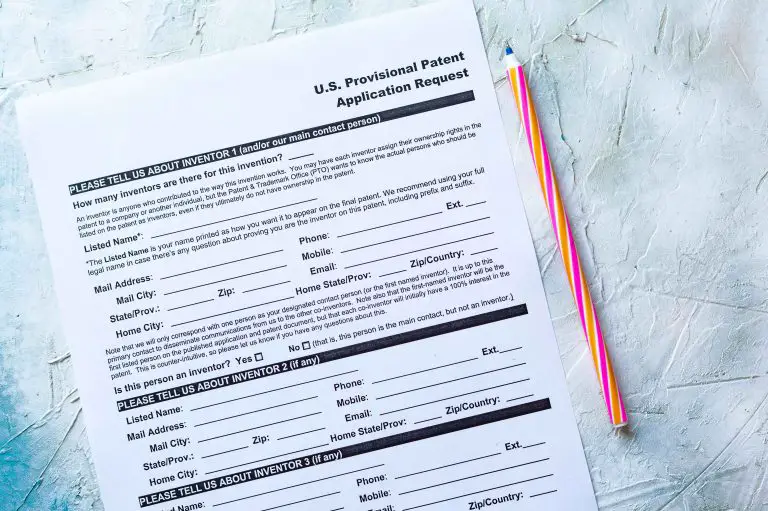What Does Patent Pending Mean?
You’ve probably purchased a product and saw the words “patent pending” on the packaging so you’re wondering what does patent pending mean? Patent pending means that an inventor has filed a patent application to protect an idea or invention with the United States Patent and Trademark Office (USPTO) but has not been granted a patent. After filing a utility, design, or plant patent application, the Patent Office gives you a patent pending serial number to alert the public that you’re actively seeking to patent your product or invention.
Patent pending indicates that an inventor is seeking protection, but the scope of protection, or whether a patent will even issue is still undetermined.
Now that you know what patent pending means, you should know that while your patent is pending, you do not have a monopoly over your invention just yet. While your patent is pending at the patent office, an inventor will not be able to sue others for using, making, or selling his invention. An inventor gains the right to restrict others from making and selling his invention once the patent office grants his utility patent application.
You will legally be able to restrict others from using or selling your invention once the USPTO approves or otherwise grants your patent application. Once your patent issues, you can sue anyone who uses or sell your idea or invention.
Your Rights While Your Patent is Pending
While you can’t legally enforce your patent to prohibit others from using, making, or profiting from your invention or idea while your patent is pending, you do have some rights. If you have a patent application that is pending, you do have some legal rights if someone else tries to patent something that’s the same or similar to your invention.
If someone files a patent that’s the same or similar to yours, the USPTO will examine each application and will give priority to the application that was first filed.
The filing date is very important in patent law because the United States has a first to file rule that gives priority to the person who first files their patent application. So, it’s very important for you to file your patent application as soon as possible before anyone else does.
It’s good practice not to disclose or talk about your invention with anyone before you patent it because if anyone knows the details of your invention, they might file an application with the USPTO before you get a chance. Unfortunately in the U.S even if you invented something first but filed second, the person filing first will have priority over you and could stop you from using or profiting from your own invention if the USPTO grants them a patent.
Provisional Patent Pending
The patent pending status is given when you file for a provisional patent, as well as a non-provisional patent. That said, if you first file a provisional patent application, to maintain your patent pending status, you will need to file a non-provisional patent application within 12 months of filing your provisional patent application. Failure to file a nonprovisional patent application will cause you to lose your patent pending status.
Patent pending status starts whether you file a provisional or nonprovisional patent application. The status ends when you abandon your patent application or your patent is granted.
Patent pending status can remain for a few years depending on the backlog of patent applications at the USPTO. Utility patents are currently taking 28 months on average.
Benefits of Patent Pending
Patent pending status is important for a few reasons that we will now cover.
#1) Patent Pending Alerts Competitors
The first advantage of having patent pending status is to alert other companies that you’re in the process of obtaining a patent.
This can deter your competitors from trying to copy your invention. Most companies will not spend money to develop a competing product if they believe that they may infringe on a patent that you may receive in the future.
Without the patent pending status, your potential competitors will have no reasons to think that anyone will object to them copying your product and selling their own variation. Patent pending status may convince your competitors that copying your product or process is not worth the risk.
#2) Patent Pending Status Indicates a New and Inventive Product
The second advantage of patent pending status is that it indicates that your product is new and inventive. Patent pending status can do wonders for your marketing efforts because it invites both your potential customers and investors to believe that your product is special since you made the effort and spent your money to protect it by filing a patent application.
Also, once you’ve filed your patent application, the USPTO will assign you a patent pending serial number that you can add to your product, it’s packaging, and accompanying materials, adding authenticity to your product.
#3) Patent Pending Status Helps you Build a Stronger Case Against Infringers
When you list “patent pending” or “patent applied for” on your product or it’s packaging, you will have a stronger argument in court that the infringer’s knowingly copied your invention or product. If you can show that an infringer willfully infringed upon your patent, you may be able to persuade the court to award you more damages.
That said, you cannot take legal action against anyone for infringing upon your patent before the patent office grants your patent application.
In some cases, you might even be able to get an injunction prohibiting another party from making or selling your invention, but courts are often hesitant to take any sort of legal action before your patent application is approved by the patent office.
#4) Patent Pending Indication Signifies Innovation
Patent pending notice can be used on a broader level to indicate that your company is innovative is coming up with new and important inventions that deserve legal protection. Also, this notice associates your company with innovation and tells potential customers and investors that you are serious about investing in new tech and protecting your creations.
Overall, notifying the public that you have a pending patent application has benefits, but it’s important to balance the benefits with the potential risks. One of the risks you run by filing a patent application is that a competitors will patent around your claimed invention by designing and patenting a product that achieves a desired result differently. That said, some protection is better than none.
When Can you Use “Patent Pending” Status?
You can only write patent pending on your product or invention only after submitting your patent application to the USPTO. Once you’ve submitted your patent application you can decide whether to include “patent pending” on your product or its accompanying materials.
If you have not yet filed your patent application and do not plan on doing so, do not advertise your product as “patent pending.” Fraudulently using the patent pending designation is against the law, so exercise caution when marking products or processes that are not covered by a pending patent application.
How to Get a Patent Pending
To get the patent pending status you can either file a provisional patent application or a non-provisional patent application with the USPTO. Provisional patent applications are less strict and are the quickest way to get patent pending status.
This will allow you to share your invention or idea with the public while reducing the threat of anyone stealing your idea. The fee you need to pay to file a provisional patent application depends on the size of your business. Here are the USPTO fees for provisional patent application as of June, 2019:
- Micro Entity: $70
- Small Entity: $140
- Large Entity: $280
Filing a provisional patent application to get patent pending status is the lowest cost option you have. All you need to file a provisional application is a detail description of how your invention words, the applicable use of your invention, and drawings of your invention.
Remember that your patent pending status is good as long as you have not abandoned your patent application. Provisional patent applications have a life of 12 months. You must file a non-provisional patent application prior to the 12 month if you want to continue to market your product as patent pending.
No Patent Pending Protection
If you do not file a patent application, you will not be able to restrict others from making, using, or otherwise selling your invention. Also, you will not be able to benefit by using the patent pending status.
Your competitors may see you as someone who doesn’t care about their intellectual property. This becomes a problem if your invention is successful, if copycats get wind of it, they might copy it and make their own competing product.
When Does Patent Pending Status End?
Your patent pending status ends when either of two things happens. It ends if (1) you abandon your patent application or (2) the patent office grants your patent application. So long as your application is pending at the trademark office, your patent pending status will remain in full effect.
Once your patent pending status ends, you must not use the words patent pending anymore. If the patent office issues or grants your patent application, you should replace the term “patent pending” with “patented.” If you abandon your application, you should immediately stop using the term “patent pending.”
How to Stop Copiers During Patent Pending?
The law does offer patent application some protection while their patent application is in its pending phase but it’s not as powerful as the protection that you’ll get if your patent application is granted.
This is so because not every patent application will become a patent. Thus, it would not be appropriate to allow patent applications to stop others from making, using, or selling the invention described in their application especially when there is a chance that the USPTO may reject their application.
To show infringement in the patent pending status, an applicant will have to show the following:
- The royalties begin after your patent is published and not the date it was filed,
- You must show that the copier had actual notice of your patent application,
- The claims in your application must be substantially identical at the time the patent application is granted as they were when the application was published
The most difficult requirement is the substantially identical requirement because inventors often make changes to the claims while the patent examiner prosecutes their patent application. During the examination stage, your patent attorney negotiates the scope of your invention with the patent examiner to determine what will be allowed in the issued patent.
Frequently Asked Patent Pending Questions
#1) Does patent pending status give full patent protection?
No, patent pending status does not provide full patent protection. To prevent others from using, manufacturing, or otherwise profiting from your invention, you will need to file and receive a full patent.
#2) What Does Patent Pending Mean?
Patent pending means that a patent application has been filed with the USPTO and although you don’t have a patent yet, you’ll be able to say that your invention is “patent pending.” It tells others that you’ve taken steps to protect your invention.
#3) Is my patent public while my patent application is pending?
USPTO claims to keep all inventions confidential until the patent is granted or the application is published. Once your patent application is published, anyone may request a copy of the application file.
#4) When Can you Start Using “Patent Pending” on your Product and its materials?
You can begin using patent pending status as soon as you file either a provisional patent application or a non-provisional patent application.
Patent Pending Concluded
We hope this article answered your common questions about patent pending status. We also explained your rights while your patent is pending and when you can using the patent pending designation. If you have any more questions regarding patent pending status of your patent application, please feel free to leave a comment below.







